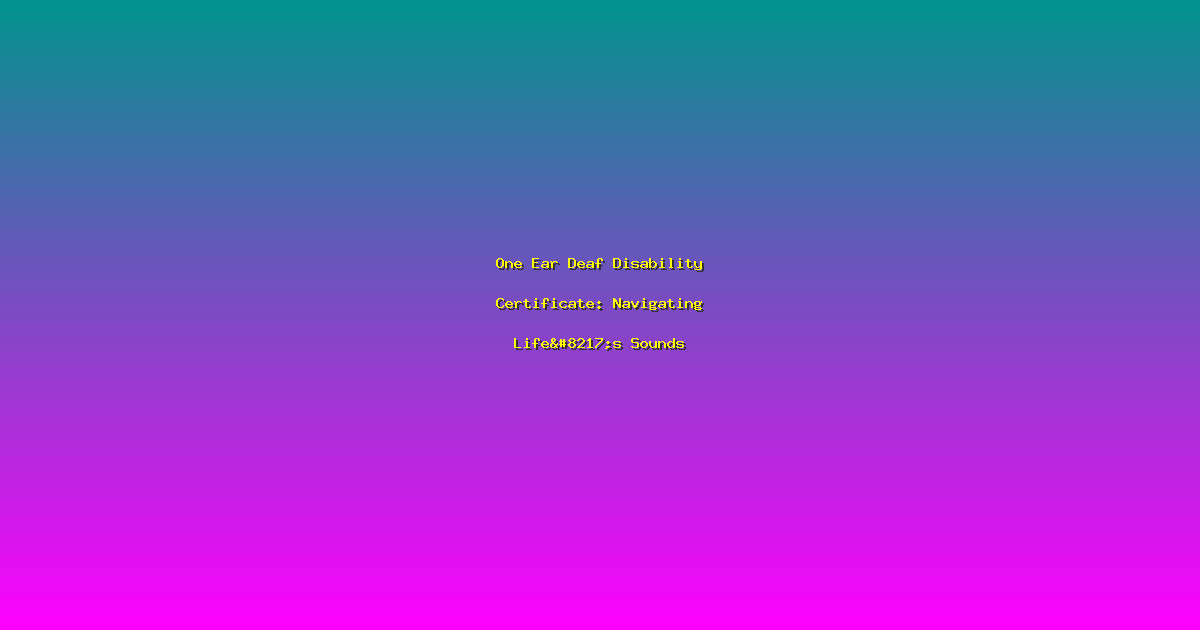One Ear Deaf Disability Certificate: Navigating Life’s Sounds
Imagine living in a world where one of your senses is compromised, yet you still manage to thrive. For those with a one ear deaf disability, life can be challenging, but it doesn’t have to be. A one ear deaf disability certificate can open doors to support, resources, and a better quality of life. This article will guide you through the process of obtaining this certificate and understanding the impact it can have on your daily life. Let’s explore how this certificate can make a significant difference.
Understanding One Ear Deafness and Its Impact
One ear deafness, also known as unilateral hearing loss, affects millions of people worldwide. According to the World Health Organization, approximately 466 million people globally have disabling hearing loss. Unilateral hearing loss can significantly impact daily life, from social interactions to safety concerns. For instance, individuals with one ear deafness may struggle to locate the source of sounds, making it difficult to navigate busy environments. This condition can also lead to social isolation and mental health issues.
- Impact on daily life: People with one ear deafness often face challenges in noisy environments, such as restaurants or public transportation, where background noise can make it difficult to understand conversations.
- Safety concerns: The inability to accurately locate the source of sounds can pose safety risks, especially in traffic or emergency situations.
- Emotional and social impact: Unilateral hearing loss can lead to feelings of isolation and frustration, affecting personal and professional relationships.
Obtaining a One Ear Deaf Disability Certificate
Securing a one ear deaf disability certificate is a crucial step in accessing the support and resources you need. The process involves several steps, including a medical evaluation, documentation, and application. Here’s a detailed look at what you need to do:
- Medical evaluation: A certified audiologist will conduct a thorough hearing test to determine the extent of your hearing loss. This evaluation is crucial for obtaining the necessary documentation.
- Documentation: Gather all relevant medical records, including the results of your hearing test, and any other pertinent information that supports your case.
- Application process: Submit your application to the relevant government or disability services agency. Ensure that all required documents are included to avoid delays.
Benefits and Support Available
Once you have your one ear deaf disability certificate, you gain access to a range of benefits and support services. These resources can significantly improve your quality of life and help you manage the challenges associated with unilateral hearing loss.
- Financial assistance: Many countries offer financial support to individuals with disabilities, including those with one ear deafness. This can help cover the costs of hearing aids, medical treatments, and other necessary expenses.
- Access to assistive technology: With the certificate, you can access a variety of assistive technologies designed to enhance your hearing and communication abilities. These include hearing aids, cochlear implants, and other devices that can make a significant difference in your daily life.
- Support groups and counseling: Joining support groups and accessing counseling services can provide emotional support and practical advice from others who understand your experiences. These resources can help you navigate the challenges of living with one ear deafness.
Frequently Asked Questions
How long does it take to get a one ear deaf disability certificate?
The process of obtaining a one ear deaf disability certificate can vary depending on the country and the specific requirements. Generally, it can take anywhere from a few weeks to several months. It’s important to gather all necessary documentation and follow the application process carefully to avoid delays.
What kind of financial assistance is available?
Financial assistance for individuals with one ear deafness can include government grants, tax credits, and subsidies for medical treatments and assistive devices. The specific types of assistance available depend on your location and the severity of your hearing loss. It’s advisable to consult with a disability services agency to understand the full range of financial support options.
Can I get a job with a one ear deaf disability certificate?
Yes, having a one ear deaf disability certificate does not prevent you from securing employment. In fact, many employers are required to provide reasonable accommodations for employees with disabilities. This can include assistive listening devices, flexible work schedules, and other support measures. Your certificate can help you advocate for these accommodations and ensure a fair and inclusive work environment.
Is the one ear deaf disability certificate permanent?
The permanence of a one ear deaf disability certificate depends on the specific regulations in your country. In many cases, the certificate is valid for a certain period and may need to be renewed periodically. It’s important to stay informed about the renewal process and any changes in eligibility criteria.
What are some common misconceptions about one ear deafness?
One common misconception is that unilateral hearing loss is less severe than bilateral hearing loss. However, the challenges associated with one ear deafness can be significant and impact daily life in various ways. It’s important to understand the unique challenges and seek the appropriate support and accommodations to manage them effectively.
Conclusion
A one ear deaf disability certificate is a powerful tool that can transform your life. By obtaining this certificate, you gain access to a range of benefits and support services that can help you navigate the challenges of living with unilateral hearing loss. Whether it’s financial assistance, assistive technology, or emotional support, the certificate opens doors to a better quality of life. Don’t let the challenges of one ear deafness hold you back—take the first step towards a more inclusive and supportive environment by obtaining your one ear deaf disability certificate today.
